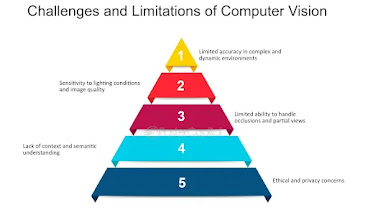Computer vision is a field of artificial intelligence (AI) that enables machines to interpret and understand visual information from the world. It aims to replicate the human visual system using algorithms, allowing computers to process and analyze visual data in the form of images, videos, and other multidimensional data. The ultimate goal of computer vision is to enable machines to "see" and make decisions based on the information extracted from visual inputs.
Key Components of Computer Vision
Image Acquisition: The first step in computer vision is the acquisition of visual data. This can be done through cameras, sensors, or other imaging devices that capture information in the form of images or videos. The quality, resolution, and lighting conditions of the data acquired are crucial for accurate analysis.
Preprocessing: Before analyzing visual data, preprocessing is often required to enhance its quality or simplify it for processing. Preprocessing techniques may include resizing, normalization, filtering, and noise reduction. This step ensures that the input data is optimized for further analysis and reduces the likelihood of errors in interpretation.
Feature Extraction: After preprocessing, the system identifies and extracts important features from the image or video. These features could be edges, textures, corners, shapes, colors, or patterns that represent meaningful information. Feature extraction helps reduce the complexity of the data and enables the system to focus on the most relevant aspects of the visual input.
Object Detection and Recognition: One of the core tasks of computer vision is identifying and recognizing objects within images or videos. Object detection involves locating objects, while recognition involves classifying them into specific categories. This is achieved through various algorithms, such as convolutional neural networks (CNNs), which are designed to mimic the way the human brain processes visual information. Object recognition is widely used in applications like facial recognition, license plate detection, and medical imaging.
Segmentation: Segmentation divides an image into multiple segments or regions to simplify the analysis of specific areas. This process helps in identifying individual objects within an image, allowing the system to isolate and analyze each part separately. Segmentation is often used in medical image analysis to identify tumors or other abnormalities in scans.
3D Reconstruction: Computer vision is not limited to 2D data. With advanced algorithms, it can reconstruct 3D models from multiple 2D images or video frames. This is useful in applications such as virtual reality, robotics, and autonomous driving, where depth perception and spatial understanding are crucial.
Motion Analysis: Another significant aspect of computer vision is motion detection and analysis. This involves tracking the movement of objects or individuals in a sequence of frames over time. Motion analysis is essential in video surveillance, human activity recognition, and autonomous vehicles, enabling systems to understand dynamic environments and respond accordingly.
Applications of Computer Vision
Autonomous Vehicles: One of the most revolutionary applications of computer vision is in self-driving cars. Computer vision systems help autonomous vehicles interpret their surroundings by recognizing road signs, detecting pedestrians, identifying obstacles, and understanding traffic conditions. This enables the vehicle to make decisions in real-time to ensure safe navigation.
Healthcare and Medical Imaging: In healthcare, computer vision plays a crucial role in diagnostics and treatment planning. For example, computer vision algorithms are used to analyze medical images such as X-rays, MRIs, and CT scans to detect abnormalities like tumors, fractures, or infections. Automated systems can assist radiologists in early disease detection, improving accuracy and reducing the time required for diagnosis.
Facial Recognition: Computer vision is the backbone of facial recognition systems, widely used in security, law enforcement, and personal devices. These systems can identify individuals based on their facial features and are used in surveillance, unlocking smartphones, and verifying identity in financial transactions.
Augmented Reality (AR) and Virtual Reality (VR): AR and VR applications rely heavily on computer vision to create immersive experiences. By analyzing the environment and detecting objects, computer vision enables users to interact with virtual elements overlaid on the real world, enhancing gaming, training, and educational experiences.
Manufacturing and Quality Control: In industrial settings, computer vision systems are used for automated inspection and quality control. These systems can detect defects, measure dimensions, and ensure that products meet specifications, reducing human error and improving production efficiency.
Challenges in Computer Vision
Despite its advancements, computer vision faces several challenges. Variations in lighting, occlusions, and the presence of complex backgrounds can complicate object detection and recognition. Furthermore, high computational power is required for real-time processing of visual data, especially in applications like autonomous driving.
Another challenge is generalization. While computer vision systems can be highly accurate in specific, controlled environments, they may struggle to perform well in unpredictable, real-world conditions. To address these challenges, ongoing research in deep learning, neural networks, and edge computing continues to drive progress in the field.
Conclusion
Computer vision is a transformative technology that is rapidly changing industries by giving machines the ability to "see" and understand visual information. With applications ranging from healthcare to autonomous vehicles, computer vision is driving innovation and enhancing the capabilities of AI systems. As technology continues to evolve, the future of computer vision holds exciting possibilities for even more sophisticated and intelligent visual systems.
"International Academic Achievements and Awards"
Visit our website : https://academicachievements.org/
To Contact us: contact@academicachievements.org
Awards Nominate : https://academicachievements.org/award-nomination/?ecategory=Awards&rcategory=Awardee
Get Connected Here:
Facebook : https://www.facebook.com/profile.php?id=100092743040677
Twitter : https://x.com/VineetaSingh28
Instagram : https://www.instagram.com/vineetasingh027/?hl=en


Thanks for sharing such brilliant ideas I really like your blog about Computer Vision in Ergonomic for us..
ReplyDelete